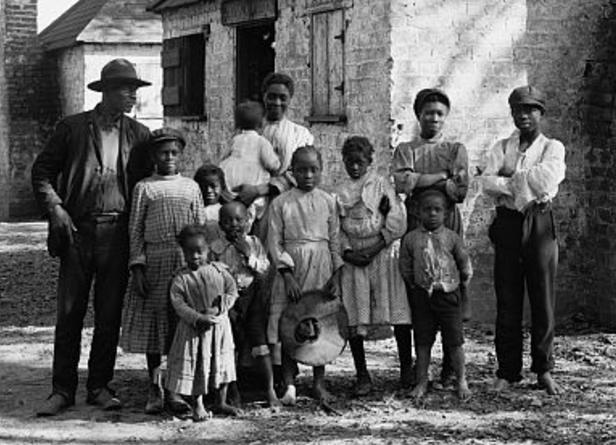
Image courtesy of National Burial Database of Enslaved Americans
The stories are infrequent but deeply compelling: one recent news item in the AP’s The Big Story describes the bones of 14 people from the 18th or early 19th century, discovered in Albany, NY, “wrapped in shrouds, buried in pine boxes and—over centuries—forgotten.” Seven adults, five infants, and two children, soon to be “publically memorialized and [re]buried in personalized boxes beside prominent families in old Albany.”
Over the 11 years since the bones’ discovery by construction workers, scientists have been able to piece together clues about what these lives were like: marked by constant toil and physical hardship. Genetic markers, and broken bones, notched and missing teeth, and arthritic joints offer the only means of identifying the remains. A granite headstone donated to the new gravesite will read, “Here lies the remains of 14 souls known only to God. Enslaved in life, they are slaves no more.”
In 1991, many miles south in lower Manhattan, a find of the remains of 419 people eventually gave rise to an even more impressive memorial and museum, the African Burial Ground National Monument, a reminder of not only the slave labor that built New York City, but also of the people bought and sold in the once bustling slave market at what is now Wall Street.

Creative Commons photo by Bruce Guthrie
Memorials like this one and the recent Albany burial site do not change the facts or right the wrongs of history, but they do make visible lives and histories long buried and forgotten. “Among the scars left by the heritage of slavery,” writes Edward Rothstein at The New York Times, “one of the greatest is an absence: where are the memorials, cemeteries, architectural structures or sturdy sanctuaries that typically provide the ground for a people’s memory?” This is precisely the question Sandra Arnold is now asking, in a very literal sense, for a project called The National Burial Database of Enslaved Americans (NBDEA).
A Graduate Fellow at Brown University, Arnold founded the Periwinkle Initiative, “a public humanities and education initiative dedicated to preserving cultural heritage associated with enslaved Americans.” The NBDEA—Periwinkle’s core project in collaboration with Fordham University, the National Endowment for the Humanities, and the 1772 Foundation—aims, writes Arnold at The New York Times, to “be the first national repository of information on the grave sites of individuals who died while enslaved or after they were emancipated.”
The grave sites The NBDEA compiles will depend in some part on the public: “Anyone who comes to the website will eventually be able to submit information about these places and conduct searches.” Currently, the site remains in development, unavailable for public searches, but users can make preliminary submissions. Arnold describes the process of sifting through the submissions she has received as “painful.”
Burial grounds that should be revered spaces… instead are covered by playgrounds and apartment complexes. I have learned that many grave sites of formerly enslaved Americans are abandoned, undocumented, desecrated by the asphalt of “development,” and lack any type of memorialization or recognition. The burial grounds are often found incidentally by developers under parks and office buildings, and for many of the sites, oral history is their only source of documentation.
Just such an oral history preserved the unmarked gravesite of one of Arnold’s ancestors in her hometown in West Tennessee. Allison Meier at Hyperallergic points to some specifically troubled sites like those Arnold describes, including “a slave cemetery… bulldozed in Houston,” another “covered with asphalt in Atlanta,” and a third “found below a Harlem bus depot.”
Arnold hopes that recording and memorializing these “sacred spaces… can contribute to healing, understanding and potentially even reconciliation.” Additionally, she cites a “pragmatic” rationale for the project, since “burial grounds are valuable resources for scholars and historians, serving as road maps for genealogical and historical research.”
The project presents a tremendous opportunity for the many thousands of citizen historians scattered across the country to come together and fill in the absences in our historical memory; and the centralized database will also draw more attention to the few memorials that do exist, many of which, writes Meier, “are often staggeringly small in relation to the number of lives they remember.” She refers to the example of a “miniature mass grave monument” in Memphis’ Elmwood Cemetary (above), a “single stone [that] memorializes over 300 slaves who died between 1852 and 1865.”
Like The Freedman’s Bureau Project, a recent online database of 1.5 million historical documents related to slavery, The NBDEA will further historicize and humanize “overlooked lives,” writes Arnold, that “are an inextricable part of the historical narrative of our country.”
Can can visit The National Burial Database of Enslaved Americans here.
via Hyperallergic
Related Content:
The Anti-Slavery Alphabet: 1846 Book Teaches Kids the ABCs of Slavery’s Evils
Visualizing Slavery: The Map Abraham Lincoln Spent Hours Studying During the Civil War
Josh Jones is a writer and musician based in Durham, NC. Follow him at @jdmagness


..Excellent article..!
Outstanding and Educational. All the members of the Race need to Read. I have emailed to all of my relatives.
Please include me in your future articles via email
Thanks
Kermit D. Allen USAF Ret. in Sacramento CA.
I am currently trying to find life and death records as well as burial site for an emancipated slave girl by the name of Rebecca Huger. Her father was John M Huger a slaveholder. She was emancipated in 1863. Can’t find where she might have been buried She either died in Charleston SC or New Orleans… Would love to let info